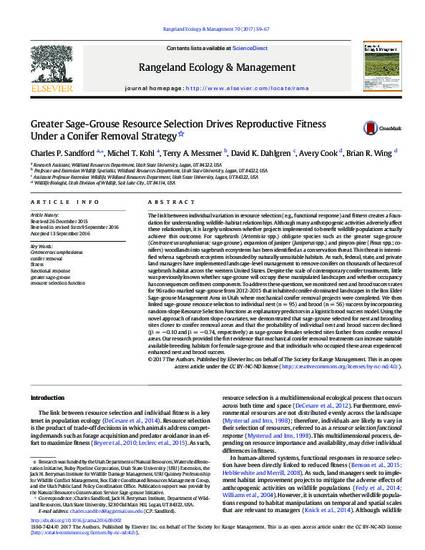
Article
Greater Sage-Grouse Resource Selection Drives Reproductive Fitness Under a Conifer Removal Strategy
Rangeland Ecology & Management
(2017)
Abstract
The link between individual variation in resource selection (e.g., functional response) and fitness creates a foundation for understanding wildlife-habitat relationships. Although many anthropogenic activities adversely affect these relationships, it is largely unknown whether projects implemented to benefit wildlife populations actually achieve this outcome. For sagebrush (Artemisia spp.) obligate species such as the greater sage-grouse (Centrocercus urophasianus; sage-grouse), expansion of juniper (Juniperus spp.) and pinyon-pine (Pinus spp.; conifers) woodlands into sagebrush ecosystems has been identified as a conservation threat. This threat is intensified when a sagebrush ecosystem is bounded by naturally unsuitable habitats. As such, federal, state, and private land managers have implemented landscape-level management to remove conifers on thousands of hectares of sagebrush habitat across the western United States. Despite the scale of contemporary conifer treatments, little was previously known whether sage-grouse will occupy these manipulated landscapes and whether occupancy has consequences on fitness components. To address these questions, we monitored nest and brood success rates for 96 radio-marked sage-grouse from 2012-2015 that inhabited conifer-dominated landscapes in the Box Elder Sage-grouse Management Area in Utah where mechanical conifer removal projects were completed. We then linked sage-grouse resource selection to individual nest (n = 95) and brood (n = 56) success by incorporating random-slope Resource Selection Functions as explanatory predictors in a logistic brood success model.
Disciplines
Publication Date
2017
DOI
https://doi.org/10.1016/j.rama.2016.09.002
Citation Information
Terry A. Messmer. "Greater Sage-Grouse Resource Selection Drives Reproductive Fitness Under a Conifer Removal Strategy" Rangeland Ecology & Management Vol. 70 Iss. 1 (2017) p. 59 - 67 Available at: http://works.bepress.com/terry-messmer/501/
